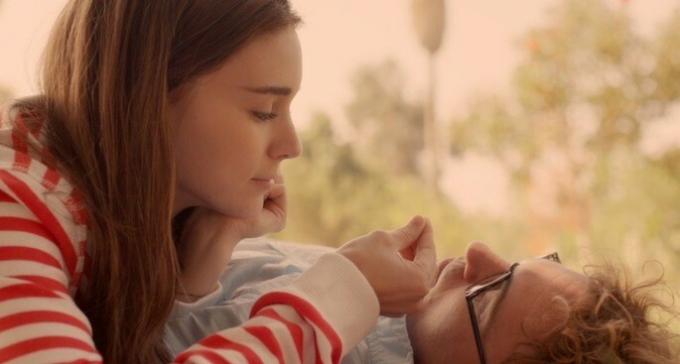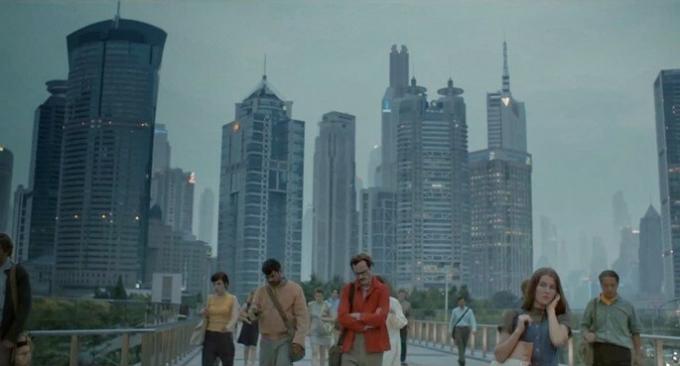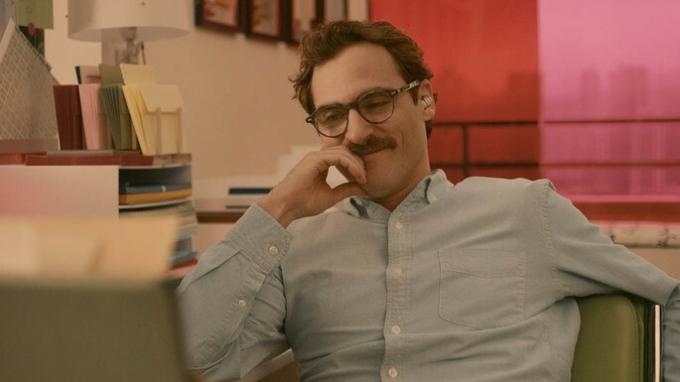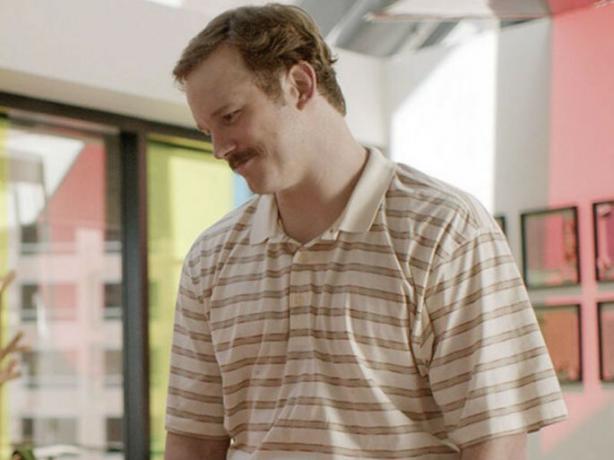Her movie: summary, analysis and characters
Her, also known as Her, is a film written and directed by Spike Jonze.
The film mixes science fiction with the romantic genre and was released in 2013. It stars Joaquin Phoenix, who plays a man who is about to get divorced and finds love again on an operating system.
This film explores, among other themes, the complexity of relationships and loneliness in a future time in which machines are increasingly humanized. Isolation in times of hyperconnection.
Let's see, next, the different reflections that this film leaves us through an analysis.

Summary of the movie
Theodore is a man who is dedicated to writing love letters commissioned by unknown people to send to his loved ones. He is a lonely individual who is in the middle of a divorce process.
Soon, in order to eradicate the situation from him, he acquires an operating system that appears to be the solution to his sad life. Theodore decides that this artificial intelligence is with a female voice, which has the name Samantha.
Little by little the protagonist establishes a relationship of friendship with his operating system and begins a relationship similar to that of two humans.
This friendship accelerates the divorce process of the protagonist, who remembers with nostalgia her time spent with Catherine and how he helped Catherine develop her career as a writer.
The day Catherine and Theodore decide to sign the divorce papers, he admits that he has a relationship with an operating system. Catherine accuses him of not knowing how to handle feelings and the protagonist remains sad and reflective.
From this moment, Theodore questions his relationship with Samantha but Amy, a friend who has another relationship with an operating system, invites him to be happy in the way he chooses. After a few days, Theodore decides to give his relationship with the operating system another chance and spends a vacation with Samantha.
During her stay, Samantha admits to having met another operating system. But her relationship with the protagonist is later twisted when, upon returning from her trip, Samantha admits that she is in love with more people and also that her relationship with another operating system has evolved to more.
Finally, Samantha ends up abandoning Theodore and he writes a thank you letter to his ex-wife Catherine.
Film analysis
The film poses a futuristic world, in which relationships between people are broken.
Individuals, like the protagonist, are not capable of solving their difficulties or expressing their feelings with others, so they resort to operating systems, in which they embody an ideal non-existent. As a result, the film shows people alone and isolated from the world around them like Theodore.
One of the reasons that makes this film great is not only the story it tells but also how, through the elements of audiovisual language, it acquires a complete meaning.
The fragility of human relationships
The main theme of the film revolves around relationships with others and how the characters that appear are unable to establish links with others.
Theodore is a writer of love letters dedicated to writing for those who do not dare or do not know how to express their feelings towards their family, friends or lovers.
In the society that he raises Her, Theodore is a love letter writer who is dedicated to writing for those who are not capable to express their feelings towards their family, friends or lovers and they need others to do it for they.
This fact is not only present in the protagonist's clients. Theodore is also not facing divorce from him. Often, he nostalgically recalls his relationship with his wife.
We see a man who does not face his problems, nor his emotions and who finds in Samantha, in the machine, a way to project what he expects or needs from a person.
In the end, his feelings towards the operating system are produced because a process of idealization of the other takes place, as in love. This "infatuation" is also frustrated at the end of the film since Samantha aspires to evolve, as it happens with people.
As a background theme, the film offers the opportunity to reflect on the capacity of technology to isolate us. A fact that arises as a consequence of not interacting with the other face to face or, simply, through a letter. People access an operating system, which they can configure to their liking. This fact causes isolation from the real world.
Theodore feels lonely and is one more isolated from the world and the people around him. This is not only reflected in history but is present in cinematography through photography and composition.
Photography and composition: from happiness to melancholy
If we look at the photographic issue and the genre of the film, Her it is quite atypical. From a futuristic film, a chromatic pattern is generally expected in which cold tones abound compared to warm ones, also that blue is present in most of the scenes.
This film departs from all tradition to present a world full of warm tones, pastels and reds. The latter predominate in any scene and take us into a more romantic than futuristic atmosphere.
The warm colors in the film are present especially in the scenes in which Theodore remembers the past with his wife, this color palette evokes a happy time.

The muted colors in the protagonist's wardrobe appear before acquiring the operating system, in the scenes in which Theodore feels lonely.
From the moment Samantha appears, the protagonist wears red, which emerges with a more passionate meaning. This may indicate that Theodore has found "someone" in the midst of his personal crisis and, suddenly, his desire to give or receive love appears.

In the saddest or melancholic scenes, cold colors are also present around the character. Which is isolated from the world around him thanks to the use of red in his wardrobe.

The predominant use of close-ups in Her contributes to creating an intimate distance with the performer and facilitates the viewer's empathy with the character.
The shallow depth of field is also of great importance. In this way, the character remains distant from the world around him, evoking this feeling of loneliness and isolation.
The interpretation of Joaquin Phoenix
How can a love relationship be credible to us, between Samantha and Theodore, if all we see is a single man in each scene?
In this sense, apart from the cinematographic technique that contributes to that evocation described Previously, the interpretation of Joaquin Phoenix could be considered as one of the keys to the success of this story.
In this role, Phoenix stands out for his ability to recreate this atmosphere full of melancholy, which possibly arises through the images that he creates in his head. Thanks to them, he manages to transfer the viewer to this "emotional scene".
Without this atmosphere, his actions and his words, especially his monologues when he talks to Samantha, would be meaningless.
The soundtrack: music, speech and silence
The character's sense of loneliness, the melancholy that haunts the film almost entirely, is completed thanks to the soundtrack.
In this sense, within the elements of the soundtrack, of this film we can highlight the importance of music, words and, especially, silences.
The music is dominated by strings and piano pieces that perfectly reconstruct the sensations that Jonze intends to convey with the film. Music is not a background element, it creates the mood. Topics such as “Song on The Beach” by the band Arcade Fire and Owen Pallet stand out.
The word contributes to the slow rhythm of the camera movements to introduce us to this loneliness and melancholy of Theodore. In this sense, it is important to highlight the voice-over of the character. It is also essential to meet a character who never physically appears on screen, Samantha.
Finally, silence is very present in some scenes in which the interpreter's face says it all and also helps to maintain this slow pace in the narration.
Characters
Theodore Twombly (Joaquin Phoenix)

He is an ordinary man who feels lonely in a world full of people. He is facing a separation and is immersed in what seems like an existential crisis. He soon acquires Samantha, an operating system with a female voice, which will make him face his day to day life and with which he ends up falling in love.
Samantha (voiced by Scarlett Johansson)

Samantha is a revolutionary operating system (OS1), which only appears in the movie identified by voice. It is an intuitive system that has human qualities and becomes a great advisor for the protagonist.
Catherine (Rooney Mara)

She is a writer and Theodore's wife, with whom he shared a life in the past. However, Catherine wants to divorce her husband, although he tries to avoid it.
Amy (Amy Adams)

Amy had a relationship with Theodore during college years, after which they became good friends. She is married to Charles, from whom she eventually separates. Later, the young woman maintains a relationship with an operating system.
Paul (Chris Pratt)

She works with Theodore as a love letter writer. One day he proposes to his partner to go out with their respective partners.
Audiovisual references reminiscent of Her
This science fiction story exposes the relationship between man and machine, a love-type bond. Something nothing new and that has already been explored in other films and series. Here are some examples of these stories:
- 2001: a space odyssey (Stanley Kubrick, 1968): a journey through the history of mankind through a space mission led by artificial intelligence.
- Blade runner (Ridley Scott, 1982): in the near future, a detective is on a mission to track down dangerous androids posing as humans to destroy their creator.
- Terminator (James Cameron, 1984): the evolution of machines poses an apocalyptic situation that threatens the continuity of human beings on the planet.
- Robocop (Paul Verhoeven, 1987): a wounded policeman is transformed into an indestructible robot that still has his memory and has plans for revenge.
- The bicentennial man (Chris Colums, 1999): a robot is acquired by a family for basic tasks but little by little it experiences emotions.
- AI. Artificial intelligence (Steven Spielberg, 2001): raises the possibility that machines are prepared to love and have feelings. Something that differentiated them from humans.
- I robot (Alex Proyas, 2004): in the year 2035 robots and humans coexist in harmony thanks to the laws of robots, which do not allow to harm people. One day, one of the androids is charged with murder.
- Ex- Machina (Alex Garland, 2015): the creation of an artificial intelligence capable of reasoning raises what is the limit between the machine and the human being, what differentiates us, what defines us.
- Black Series Mirror (Charlie Brooker, 2011-): in some of the episodes he covers the power that technologies have over the world.
- Real Humans Series (Lars Lundström, 2014-): hubots are human-like androids that are acquired by families to perform different tasks. Some mark them as usurpers but the robots are willing to fight for their rights. In it, issues such as identity are raised.
- Westworld Series (Jonathan Nolan and Lisa Joy, 2016-): androids are part of a theme park, where visitors are willing to take any risk.

